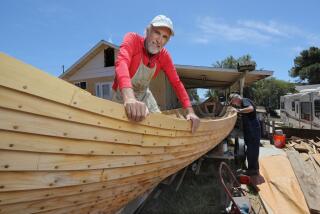VENTURA : A Beached Yacht Begins to Take Shape
- Share via
It sits in a dusty boatyard just off California 33 on the outskirts of Ventura, a healthy set of ribs partly obscured by scaffolding and veils of bright blue plastic.
Midway between the drawing board and the deep blue sea, the boat may take its maiden voyage out of Ventura Harbor as early as 1992 as the Bloodhound II, a replica of one of the 19th-Century’s most celebrated racing yachts.
The replica is the dream of Los Angeles architect, builder, filmmaker and yachtsman Robert Gilbert. His quest to build the boat, estimated to cost $600,000, began in 1986 when he was looking through a collection of pictures. He was captivated by the Bloodhound in full sail and began the quest for every detail about the boat’s past.
He hired two part-time researchers, dubbed them the “wooden boat probes,” and sent them to England and Scotland in search of the Bloodhound’s history and working plans.
They found that the original yacht had been built by William Fife II in 1874 in Fairlie, Scotland. Considered a master boat builder, Fife had no trouble finding a buyer in the Marquis of Ailsa, who raced the vessel lucratively for 15 years before it was sold.
When the Bloodhound ended up at a wrecking yard in 1907 to be sold for the price of its lead ballast, the marquis rescued and successfully raced it against much newer boats. The Bloodhound was destroyed in a fire at Fife’s boatyard in 1922, but the Bloodhound’s beauty, charm and speed had earned it a place in yachting history.
Gilbert’s researchers found drawings and plans for the Bloodhound through the Marquis of Ailsa’s descendants at the family castle in Scotland.
Armed with the faded documents, Gilbert hired San Francisco marine architect Mike Richardson to create new working plans.
The boat is being built by Harvey Swindall of Fine Yacht Interiors in Ventura. Swindall designed and restored the interior of one of Gilbert’s former yachts 10 years ago.
“You just get to do one of these in a lifetime,” Swindall said. Since he began making the smaller pieces of the boat in his workroom 2 1/2 years ago, he has logged about 6,000 hours of work on Bloodhound II.
Gilbert said he tries “to form a shell around Harvey so that he can do what he needs to do without interruption or worry.” Gilbert works alongside Swindall about three days a week.
The product of their labors will weigh 52 tons, including its 23-ton lead keel, measure 92 feet from bowsprit to stern and carry a 92-foot mast. The original Bloodhound displaced 48 tons. The additional weight comes from the use of wood from a tree that grows along the Amazon. The wood was brought in by tramp steamer.
Unlike the oak used in most domestic boats, this wood is shock resistant and has a low acid content, so it doesn’t react with metal.
“We’re doing most of the Bloodhound II the way the Fifes would have done it instead of just throwing a boat together,” Swindall said. “We’ve all been at sea and know what the ocean has to offer up, and it’s something we don’t want to have to worry about. We’ll worry about everything else but not about the boat falling apart.”
What isn’t being done in the Fife tradition is requiring both Gilbert and Swindall to devise new systems, parts, and machinery to invent technology as they go.
“You can’t do everything like the Fifes did or you’d go nuts,” Swindall said. “In some cases, old is not necessarily better.”
Bloodhound II will make her debut in the wooden boat meets off the California coast and then, if Gilbert’s dreams become reality, the boat will be shipped to New York and sailed across the Atlantic to Scotland.
More to Read
Sign up for The Wild
We’ll help you find the best places to hike, bike and run, as well as the perfect silent spots for meditation and yoga.
You may occasionally receive promotional content from the Los Angeles Times.






